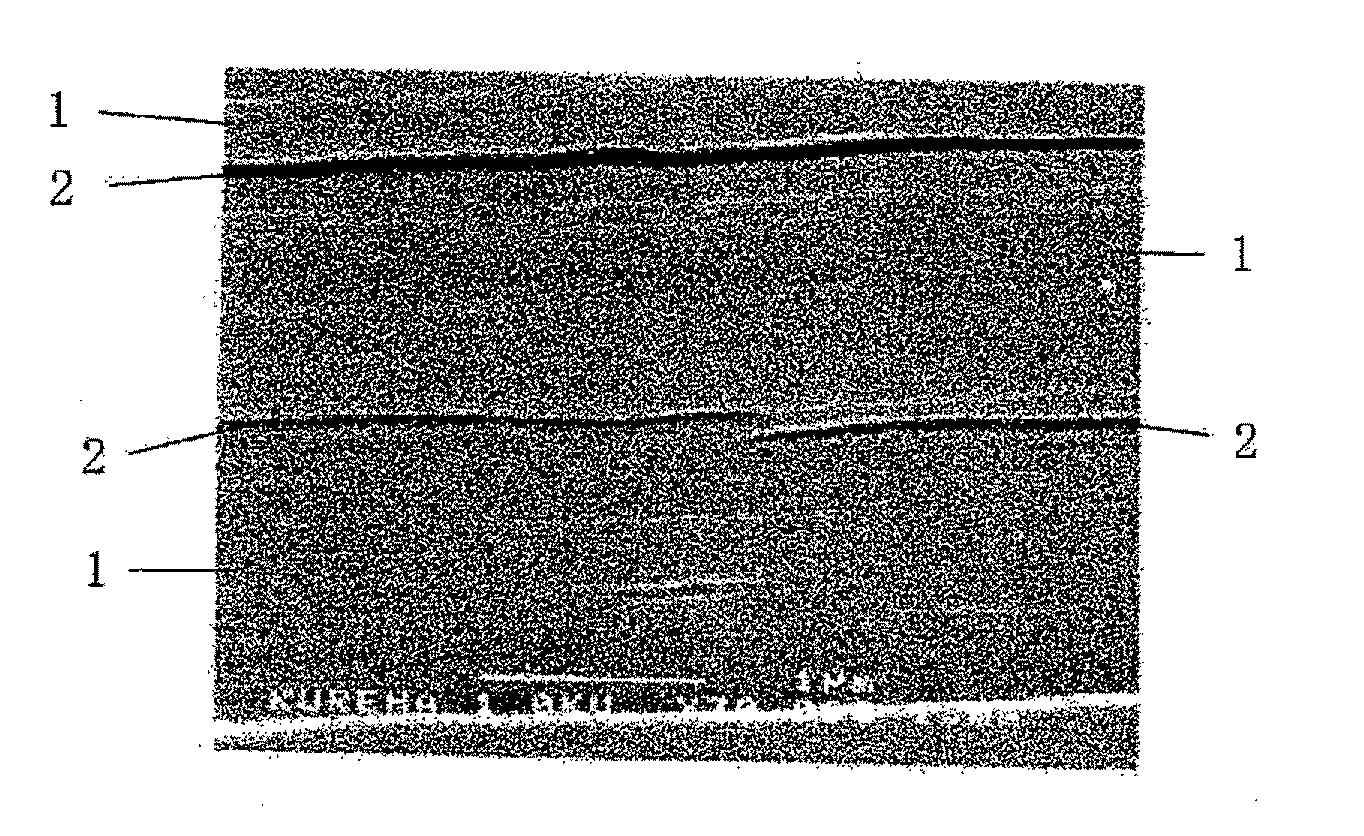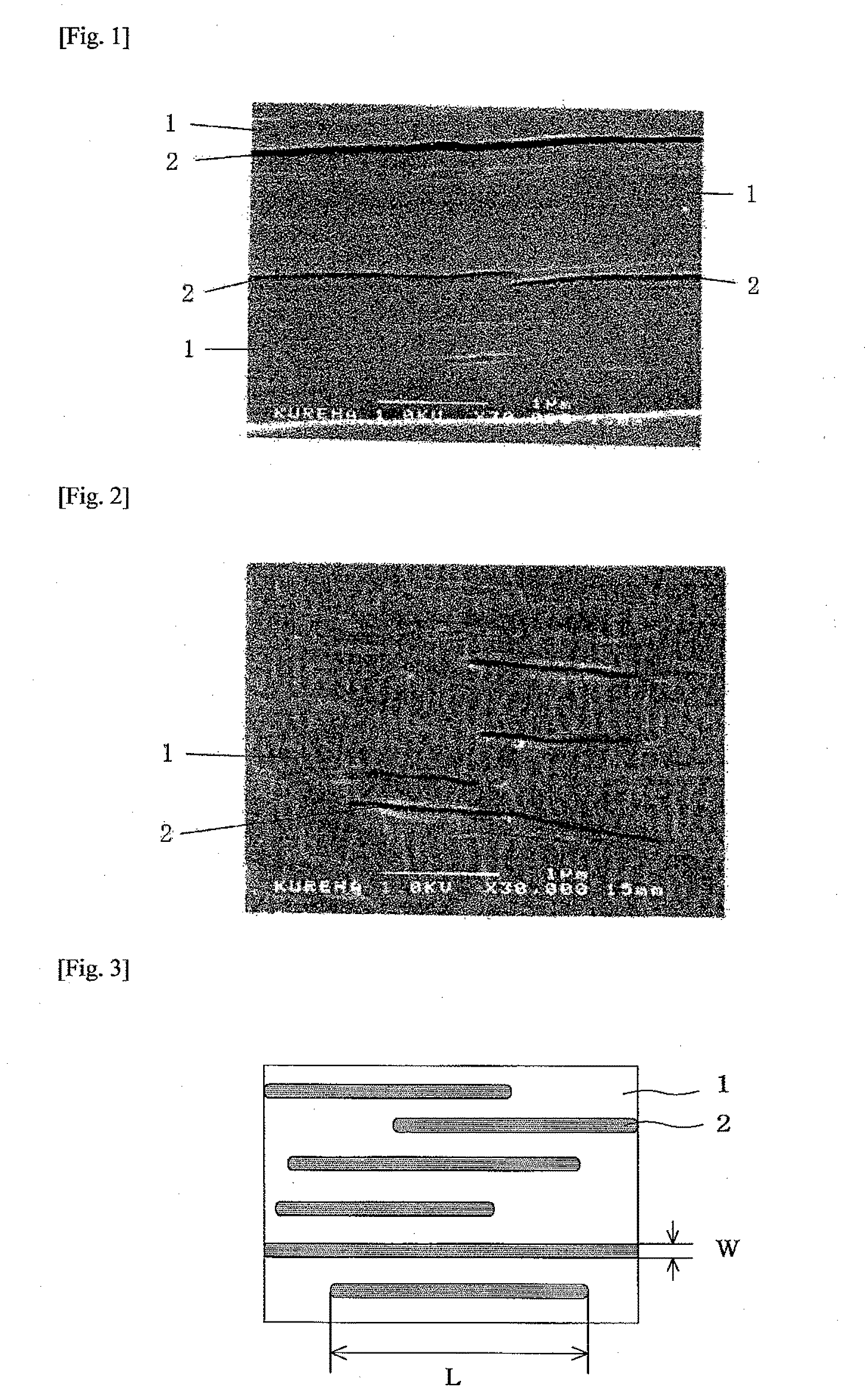Polypropylene Resin Composition, Formed Product Composed of the Resin Composition, and Production Process of the Formed Product
- Summary
- Abstract
- Description
- Claims
- Application Information
AI Technical Summary
Benefits of technology
Problems solved by technology
Method used
Image
Examples
example 1
[0141]A biaxially oriented film having a thickness of 3 μm was prepared in the same manner as in Comparative Example 2 except that in addition to the 80 parts by weight of the polypropylene pellets and 20 parts of the polyglycolic acid pellets, an ethylene / glycidyl methacrylate / methyl acrylate copolymer (BOND-FAST, product of Sumitomo Chemical Co., Ltd.) was blended in a proportion of 6.5 parts by mass per 100 parts by weight of these resin components.
[0142]SEM photographs (magnification=30,000 times) of sections in the thickness-wise direction of the resultant biaxially oriented film are illustrated in FIGS. 1 and 2. As apparent from FIGS. 1 and 2, it is understood that the polyglycolic acid resides in the morphology dispersed as individually independent plural thin films in a state stacked through a polypropylene layer at a section in the thickness-wise direction along MD of the biaxially oriented film, and a section in the thickness-wise direction along TD. With respect to the me...
example 2
[0143]A biaxially oriented film having a thickness of 3 μm was prepared in the same manner as in Comparative Example 2 except that in addition to the 80 parts by weight of the polypropylene pellets and 20 parts of the polyglycolic acid pellets, maleic anhydride-grafted polypropylene (MODIC, product of Mitsubishi Chemical Corporation) was blended in a proportion of 10 parts by mass per 100 parts by weight of these resin components.
[0144]SEM photographs (magnification=30,000 times) of sections in the thickness-wise direction of the resultant biaxially oriented film were taken. As a result, it was proved that the polyglycolic acid resides in the morphology dispersed as individually independent plural thin films in a state stacked through a polypropylene layer at a section in the thickness-wise direction along MD, and a section in the thickness-wise direction along TD.
[0145]With respect to the melt-extruded sheet before the biaxial orienting, SEM photographs (magnification=30,000 times)...
example 3
[0151]A biaxially oriented film having a thickness of 12 μm was prepared in the same manner as in Comparative Example 3 except that 10 parts by mass of maleic anhydride-grafted polypropylene (MODIC, product of Mitsubishi Chemical Corporation) was blended with 100 parts by weight of a resin component composed of 80 parts by weight of the polypropylene pellets and 20 parts of polyglycolic acid pellets.
[0152]The polyglycolic acid pellets are those obtained by adding a heat stabilizer AX-71 (mono- and / or di-stearyl acid phosphate; product of ADEKA CORPORATION) in a proportion of 0.03 parts by mass to 100 parts by mass of a ring-opening polymer of glycolide having a melt viscosity of 785 Pa·s. The results are shown in Table 2.
PUM
| Property | Measurement | Unit |
|---|---|---|
| Temperature | aaaaa | aaaaa |
| Temperature | aaaaa | aaaaa |
| Temperature | aaaaa | aaaaa |
Abstract
Description
Claims
Application Information
 Login to View More
Login to View More - R&D
- Intellectual Property
- Life Sciences
- Materials
- Tech Scout
- Unparalleled Data Quality
- Higher Quality Content
- 60% Fewer Hallucinations
Browse by: Latest US Patents, China's latest patents, Technical Efficacy Thesaurus, Application Domain, Technology Topic, Popular Technical Reports.
© 2025 PatSnap. All rights reserved.Legal|Privacy policy|Modern Slavery Act Transparency Statement|Sitemap|About US| Contact US: help@patsnap.com



